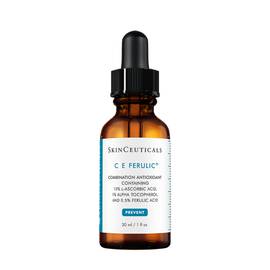RETINOIDS
PRESCRIPTION TREATMENT TO HELP TREAT ACNE, VISIBLE SIGNS OF AGING, AND SUN DAMAGE.

Retinoids are among the most researched and recommended skincare ingredients for acne and are favored by dermatologist for their anti-aging benefits—they can also help complement the results achieved with professional office-based procedures.
FAQS
RETINOIDS EXPLAINED
Retinoids are a family of skincare ingredients that have been clinically proven to promote cellular turnover, stimulate the skin’s natural production of collagen and elastin, and reduce the appearance of dark spots and discoloration. They are effective for minimizing acne and have been shown to improve visible signs of aging such as fine lines, wrinkles, and sun damage.
Retinoids can be recommended in conjunction with professional treatments such as chemical peels, Intense Pulsed Light (IPL), lasers, medical facials, Hydrafacial® treatments, and microdermabrasion. They can also help complement the results of neurotoxins and dermal fillers by improving the appearance of the skin's tone and surface texture.
WHAT ARE RETINOIDS?
All retinoids are derivatives of vitamin A and these ingredients come in several forms. One of the most commonly used prescription retinoids is tretinoin (all-trans-retinoic acid), which can be directly recognized by the skin. More recent generations of retinoids include adapalene and tazarotene which possess a different chemical structure than retinoic acid, but can mimic its activity in skin. Over-the-counter retinoids include retinol, as well as derivatives such as retinaldehyde and retinyl esters. Skincare professionals often suggest using retinoids at home as they have been shown to address visible signs of aging and acne, as well as to complement office-based treatments.
WHO ARE RETINOIDS FOR?
Retinoids are recommended by physicians for anyone concerned about visible signs of aging such as fine lines, wrinkles, discoloration, and sun damage, as well as those who experience acne.
For those experiencing visible signs of aging, retinoids can help reinforce the results of a variety of professional treatments. The skin-smoothing effects of retinoids can complement exfoliating treatments like chemical peels and microdermabrasion as well as laser resurfacing procedures. In addition, those with acne-prone skin can benefit from using retinoids in conjunction with salicylic acid chemical peels and medical facials that are customized to address blemishes.
HOW DO RETINOIDS WORK?
Retinoids have several effects on the skin. Topical retinoids have been proven to increase the collagen production in skin to help smooth the appearance of fine lines and wrinkles1 associated with sun damage, and the increase in skin-cell turnover can improve the look of discoloration. The boost in the skin’s natural exfoliation that results from on-going use of retinoids can also help prevent pores from becoming clogged with dead skin cells, which plays a role in minimizing the formation of acne.2
The main difference between prescription-based retinoids and over-the-counter derivatives is potency, which is related to the amount of “conversion” required within the skin to reap these ingredients’ benefits. The prescription-based retinoid tretinoin delivers retinoic acid directly to the skin. Pure retinol is biologically converted to retinoic acid by the skin after application. Derivatives of retinol, such as retinyl esters must first convert to retinol and then to retinoic acid by the skin after application—which can result in decreased potency.3 SkinCeuticals retinol creams contain between 0.3-1% pure retinol and are equipped with the latest stabilization technology to ensure a steady and even release to the skin. Consult with your skincare professional to learn more about retinoids and pure retinol.
1https://www.ncbi.nlm.nih.gov/pmc/articles/PMC2699641/
2https://www.ncbi.nlm.nih.gov/pmc/articles/PMC6273829/
3https://www.wellandgood.com/good-looks/what-are-retinoids/ (Quotes from Dr. Zeichner).
HOW OFTEN SHOULD I BE USING RETINOIDS?
When using retinoids for the first time, it’s important to incorporate them into your skincare routine slowly. Limit initial use to once or twice a week, gradually increasing frequency to every other night, then every night as tolerated.
Consult with your skincare professional to learn more about retinoids.
WHAT WILL I EXPERIENCE WHEN USING RETINOIDS?
It’s common to experience flaking, dryness, redness, and other signs of irritation when starting to use retinoids, which is why it’s essential to start slowly and gradually increase frequency of use. The exfoliating effects of retinoids can also lead to increased sun sensitivity, so it’s imperative to use a daily sunscreen with an SPF of at least 30 when using this ingredient.
Triple Lipid Restore 2:4:2 has been clinically proven to help improve the skin’s tolerance when starting to use tretinoin—and decrease the skin adjustment period to one week.1 This translates to less dryness and irritation when using retinoids like tretinoin. Triple Lipid Restore 2:4:2 also helps replenish the essential skin lipids that decline with age and improves the appearance of skin fullness, texture, evenness, and radiance while minimizing the look of pores. Always speak with your skincare professional before starting use of a prescription retinoid.
1Protocol: A 4-week, single-center, double-blind, randomized, split-face clinical study on 17 female subjects ages 38–64, Fitzpatrick type I–V.>
WHERE CAN I GET RETINOIDS?
Although retinol and the retinoid adapalene are available over-the-counter, prescription retinoids are generally prescribed by a medical or skincare professional. Getting a prescription can be as easy as scheduling an appointment with one of these specialized providers, who can also recommend the ideal in-office treatments and procedures that can work in conjunction with retinoids to help you achieve your skin-improvement goals.
Find a skincare professional near you >
SHOULD I INCORPORATE AN AT-HOME SKINCARE REGIMEN?
It is recommended to incorporate an at-home skincare regimen after retinoid application. Skinceuticals Triple Lipid Restore 2:4:2 can help reduce dryness and irritation when used alongside topical retinoids. Always consult with your physician for individual at-home advice.

/22_0429_SKC_PDP22_PVT_CEF_US_TEXTURE_2400x2400.jpg?sw=270&sfrm=jpg&q=70)
